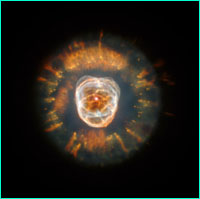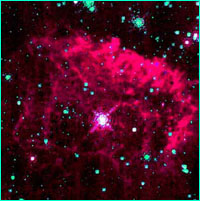
|
 |
|
Part 2 | Back to Part 1 This finding helped lead to a new theory of carbonado formation. In 1985, Joseph Smith of the University of Chicago and J. Barry Dawson of the University of Sheffield in England suggested in an article published in the scientific journal Geology that large meteor impacts in the Precambrian Era (roughly 570 million years ago back to Earth's beginning some 4.5 billion years ago) formed the black diamonds we find today. Scientists had long deemed carbonados quite old, because the streams where they are typically found cut through geologic strata dated from one to more than two billion years old. In fact, recent atomic measurements of black diamonds have placed their origins at nearly four billion years ago, a time when a constant barrage of giant meteors battered the Earth. In the 1990s, other scientists showed that Brazilian and African carbonados bear similar isotopes of carbon and nitrogen, suggesting a common origin, while still others provided theoretical and physical evidence that black diamonds could have arisen during the extreme shock and heat of a meteor impact. But why, some scientists wondered, had no unambiguous evidence ever been shown for craters associated with carbonados? Geologist Stephen Haggerty of the University of Massachusetts at Amherst had an idea why, and he shared it with a dumbfounded audience at a 1996 American Geophysical Union meeting in Baltimore. Carbonados were born not on Earth, either the way regular diamonds are or by meteor impact, he said. Rather, they originated in dying stars, when shock waves from exploding red giants crushed carbon into dense aggregations of black diamond and sent them hurtling into deep space. Eons later, the Sun's gravity lured some of this material into our solar system, where blocks of it slammed into our atmosphere, shattering into the fragments we find strewn over select areas today, perhaps billions of years after they formed.
Even nearby planets may be churning out diamonds. In fact, planetary scientists say that Uranus and Neptune, the seventh and eighth planets from our Sun, respectively, may rain diamonds, which then pile up miles-thick at the planets' cores. Uranus and Neptune are each nearly four times the size of Earth. Scientists believe that, beneath an outer layer of hydrogen and helium, the gaseous atmospheres of both planets contain 10 to 15 percent methane, a hydrocarbon. Deep within the extremely dense atmospheres, above a rocky core, these planets are also thought to bear temperatures ranging from 3,000 to 12,000°F and pressures varying from 200,000 to six million times the pressure of our own atmosphere (which is 14 pounds per square inch). In other words, possibly ideal conditions for producing diamonds.
Reaping the benefits As for tapping the riches of any diamonds from space, don't hold your breath. Earth-hitting meteorites that either bear or engender diamonds are few and far between, and unlike diamonds you're likely used to, their associated diamonds often cannot be seen, much less admired, with the naked eye. Black diamonds, for their part, are rare and are primarily used for industrial purposes. And the challenges of harvesting any diamonds on Uranus and Neptune, which are roughly 1,700 and 2,720 million miles away from Earth, respectively, are as clear as the Koh-i-Noor diamond. Alas, scientific understanding is the primary beneficiary of diamonds from the heavens. Peter Tyson is Online Producer of NOVA. Further reading (see also Books under Resources) "Prospecting for Diamonds in the Outer Planets," by Warren E. Leary, The New York Times, 10/5/99. "Giant Black Diamonds Of Mysterious Origin May Hail From Space," by William Broad, The New York Times, 9/17/96. Photos: (1,2,5-7) NASA; (3) courtesy of Justin Gould; (4) courtesy of Stephen Haggerty. The Science Behind the Sparkle | Diamonds in the Sky A Primer of Gemstones | See Inside a Diamond Resources | Transcript | Site Map | Diamond Deception Home Editor's Picks | Previous Sites | Join Us/E-mail | TV/Web Schedule About NOVA | Teachers | Site Map | Shop | Jobs | Search | To print PBS Online | NOVA Online | WGBH © | Updated November 2000 |
 Did carbonados form in the unimaginably explosive
shock waves emitted by dying stars, such as this one
shot recently by NASA's Hubble Space Telescope?
Did carbonados form in the unimaginably explosive
shock waves emitted by dying stars, such as this one
shot recently by NASA's Hubble Space Telescope?
 Uranus (left) and Neptune may be veritable diamond
factories.
Uranus (left) and Neptune may be veritable diamond
factories.
 For the foreseeable future, the greatest benefit
we'll see from diamonds in the sky will be improved
scientific understanding.
For the foreseeable future, the greatest benefit
we'll see from diamonds in the sky will be improved
scientific understanding.